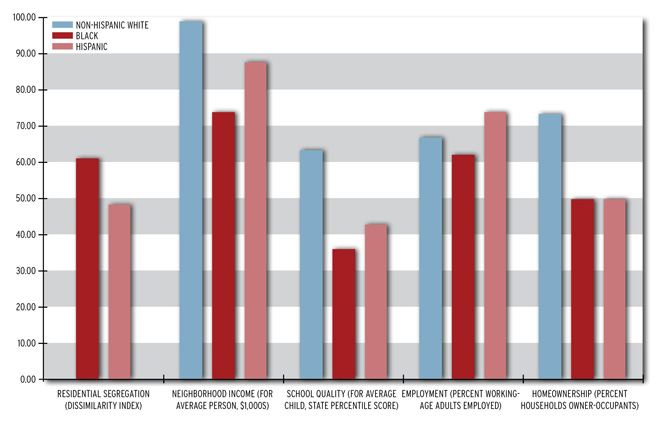At the time of Martin Luther King's death, most American urban areas, in the North as well as the South, were highly segregated, and African Americans were denied equal access to good schools, well-paying jobs, and homeownership—all essential pathways to economic success. Today, more than four decades later, the disparities have narrowed considerably, and growing numbers of black Americans have succeeded in climbing the ladder of social and economic opportunity. But African Americans (on average) still don’t enjoy the same school quality, job opportunities, or homeownership access as whites.
To complicate matters further, immigration has made our population dramatically more diverse. So the picture of racial inequity in urban America is no longer so stark—or so clearly evident. Some metros perform a lot better than others for their minority residents. And some serve members of one minority well but not others.
To explore this complex picture, the Urban Institute developed a "report card" that ranks the nation's 100 biggest metro areas on five factors: residential segregation, neighborhood affluence (for the average black, Latino, and non-Hispanic white), public school quality (for the average black, Latino, and non-Hispanic white student), employment (among working-age adults), and homeownership.
How does the DC region score? Not as well as you might think. For African Americans, it ranks 50th of 100 big metro areas (a C if we're grading on a curve). Residential segregation is high by national standards (although it has declined substantially over recent decades). The average African American in the DC region lives in a much lower-income neighborhood than the average white, and the average African American child attends a lower-performing school than the average white child. The DC region appears to be performing better for African Americans with respect to employment and homeownership opportunities. Although blacks are less likely than whites to have jobs or to own their own homes, these gaps are narrow by national standards.
Opportunity Gaps Among Whites, Blacks, and Latinos in the Washington, DC Metro Area

Source: Urban Institute analysis of Brown University US 2010 and 2010 Census data
Now let’s look at Latino-white equity. The DC region scores a C again—45th among the nation's 100 biggest metros. Latinos are less segregated from non-Hispanic whites than are blacks, but the DC region's Latino-white segregation levels are high by national standards, and they've been climbing for the last several decades at the same time the Latino population has been growing. The average Latino lives in a neighborhood that's higher income than the average African American's, but still lower than the average white's. And the average Latino child attends a school that performs better than the average African American child's but, again, not on par with the average white child's. Employment is high among working-age Latinos, and—as for African Americans—homeownership rates are high by national standards.
So when it comes to opportunities for its growing minority population, our region's performance is respectable but by no means laudable. Closing the remaining opportunity gaps is no simple matter. Historically, public policies played a central role in establishing and enforcing patterns of racial segregation and inequality, alongside discriminatory practices by private-sector institutions and individuals. But no single causal process explains the persistence of these opportunity gaps in the Washington region—or other American metros—and no single policy initiative can eradicate them. Instead, the evidence argues for combination strategies to address interconnected barriers like unaffordable mortgages, neighborhood distress, failing schools, and weak job markets.
I hope policymakers and civic leaders in metropolitan Washington will use our report card to start a constructive metro-wide conversation, asking “What can we do to narrow the opportunity gaps in our region?”
Let’s build a future where everyone, everywhere has the opportunity and power to thrive
Urban is more determined than ever to partner with changemakers to unlock opportunities that give people across the country a fair shot at reaching their fullest potential. Invest in Urban to power this type of work.